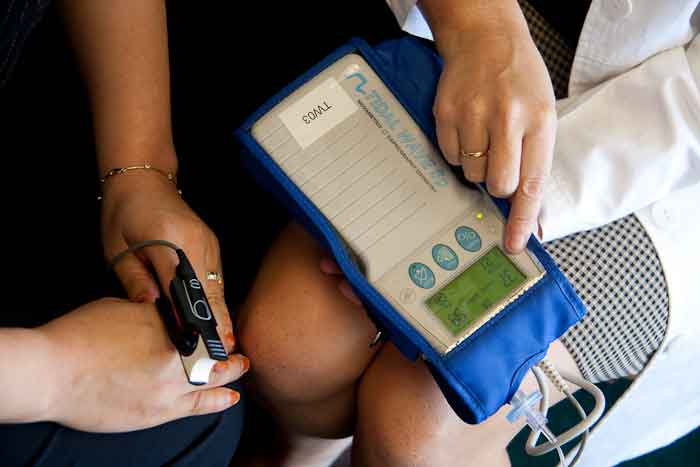 As the health care reform debate turns to cutting costs and improving treatment outcomes, two SMU professors are expanding a study that shows promise for reducing both the expense and suffering associated with chronic asthma.
As the health care reform debate turns to cutting costs and improving treatment outcomes, two SMU professors are expanding a study that shows promise for reducing both the expense and suffering associated with chronic asthma.
Thomas Ritz and Alicia Meuret, both of SMU’s Psychology Department, have developed a four-week program to teach asthmatics how to better control their condition by changing the way they breathe.
With the help of a four-year, $1.4 million grant from the National Institutes of Health, they plan to engage 120 Dallas County patients in four weeks of breathing training by the study’s projected end in July 2012. Their co-investigators include David Rosenfield, also of SMU’s Psychology Department, and Mark Millard, M.D., of Baylor University Medical Center.
 More than 22 million Americans suffer from asthma at an estimated annual economic cost of more than $19 billion, according to the American Lung Association. The number of cases doubled between 1980 and 1995, prompting the U.S. Department of Health and Human Services to classify the disease as an epidemic in 2000.
More than 22 million Americans suffer from asthma at an estimated annual economic cost of more than $19 billion, according to the American Lung Association. The number of cases doubled between 1980 and 1995, prompting the U.S. Department of Health and Human Services to classify the disease as an epidemic in 2000.
During an attack, sufferers tend to hyperventilate, breathing fast and deep against constricted airways to fight an overwhelming feeling of oxygen deprivation.
Unfortunately, this makes the problem worse by lowering the body’s carbon dioxide levels, which restricts blood flow to the brain and can further irritate already hypersensitive bronchial passages.
Patients who “overbreathe” on a sustained basis risk chronic CO2 deficiencies that make them even more vulnerable to future attacks. Rescue medications that relieve asthma symptoms do nothing to correct breathing difficulties associated with hyperventilation.
As part of SMU’s Stress, Anxiety and Chronic Disease Research Program, Ritz and Meuret use their biofeedback-based Capnometry-Assisted Respiratory Training (CART) to teach asthma patients to normalize and reverse chronic overbreathing. A hand-held device called a capnometer measures the amount of CO2 exhaled. Using this device, patients learn how to breathe more slowly, shallowly and regularly.
 CART techniques could have a positive impact on quality of asthma treatment even as they reduce the need for acute care, Ritz says.
CART techniques could have a positive impact on quality of asthma treatment even as they reduce the need for acute care, Ritz says.
“The research shows that this kind of respiratory therapy can limit both the severity and frequency of asthma attacks,” he says. “That means fewer doctor visits and less frequent use of rescue medications, with the associated savings of both time and money.”
And for those who count any year without a trip to the emergency room as a year with a good treatment outcome, that means a higher quality of life, says Meuret, who lives with asthma herself.
“The training gives patients new ways to deal with acute symptoms, and that helps them to feel more in control,” she says. — Kathleen Tibbetts
(Photos: SMU Professor Alicia Meuret uses biofeedback data to demonstrate the relationship between oxygen and carbon dioxide levels in hyperventilation.)
News coverage:
ScienceDaily
physorg.com
Health.am
e! Science News
RTMagazine.com
medindia.net
Bio-Medicine.org
medicalnewstoday.com
Related links:
SMU Research News: Deep breathing worsens panic-attack symptoms
 SMU video: Hyperventilation
SMU video: Hyperventilation
Alicia Meuret
Thomas Ritz
David Rosenfield
SMU Department of Psychology
Dedman College of Humanities and Sciences

 A new study by research psychologists
A new study by research psychologists  When a flash was followed by its identical symbol, participants were five times more likely to say they had seen that symbol sometime before the experiment.
When a flash was followed by its identical symbol, participants were five times more likely to say they had seen that symbol sometime before the experiment. The research, was published in the March issue of the journal “Psychiatry Research: Neuroimaging.” Imaging enables investigators to visualize exact brain structures affected by these chemical exposures, Haley said.
The research, was published in the March issue of the journal “Psychiatry Research: Neuroimaging.” Imaging enables investigators to visualize exact brain structures affected by these chemical exposures, Haley said. In the study, 21 chronically ill Gulf War veterans and 17 well veterans were given small doses of physostigmine, a substance which briefly stimulates cholinergic receptors. Researchers then measured the study participants’ brain cell response with brain scans.
In the study, 21 chronically ill Gulf War veterans and 17 well veterans were given small doses of physostigmine, a substance which briefly stimulates cholinergic receptors. Researchers then measured the study participants’ brain cell response with brain scans. An objective diagnostic test, he said, sets the stage for ongoing genetic studies to see why some people are affected by chemical exposures, and why others are not.
An objective diagnostic test, he said, sets the stage for ongoing genetic studies to see why some people are affected by chemical exposures, and why others are not.